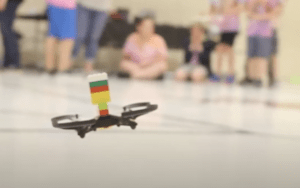
By DRONELIFE Contributor Dawn M.K. Zoldi
For more of Dawn’s in-depth content, don’t miss the next Dawn of Drones podcast, right here on DRONELIFE!
Meghan Salter, a public school teacher from Huntington, West Virginia (WV), has made it her mission to teach the children well, so they can lead the way in tomorrow’s drone industry. She has incorporated drones in her classrooms in seven of the thirteen years she has spent educating young gifted students in rural Appalachia.
Drones in Elementary Education: STEM and More
First introduced to drones in 2015 by a friend, Salter quickly realized the power they could have in the classroom teaching STEM and other subjects. She reminisced, “It was a new technology. I had no idea what drones even were back then. Most of my students had heard of them but had ever used them. It was really amazing to start one of the first elementary drone education programs in elementary.”
She convinced her leadership to proceed with a drone program and set to writing out grant proposals. From the humble beginnings of an initial $2,500 STEM grant from the WV Department of Education, she has now banked close to $30,000 in funds for drones and 3D printers, among other things, to benefit her students.
When she started her program, there was no elementary-focused course content available. So she created her own curriculum. “I had to build it all,” she recalled. “Even now when there are so many more things that teachers can find online, it can still be a struggle in elementary. Most of the curriculum focuses on middle and high school students.”
She also developed the school’s Drone Olympics for all levels of students, with a special emphasis on 5th graders. As part of this year-long project, the students put together a portfolio that includes a biography, written assignments, research projects, learning the NATO-phonetic alphabet (think: Alpha, Beta, Charlie, Delta etc.), math calculations, and more. The kids then compete against each other in various challenges that mimic real-world drone use cases. (For more see the Drone Olympics video here). Her goal was to show others that we are doing more things than just playing with drones. “There are so many ways that you can integrate it into your classroom,” she explained. “As long as you are creative and are willing to make mistakes in the process, you are ultimately going to succeed.”
These creative classroom adaptations led to her receipt of the Women and Drones Woman to Watch Education Award in 2019. Other accolades followed, including the 2020 Cabell County Teacher of the Year and the 2020 Top Finalist WV Teacher of the Year. Like so many women before her, Salter’s receipt of the Woman to Watch Award changed her life. Not only was it a “huge confidence booster” (her words), it also opened up numerous opportunities including various advisory board memberships and drone educator training facilitator roles.
Diversity remains a priority for Salter. She aims to inspire the next generation of drone ecosystem professionals and break down stereotypes, especially for her female students. Originally from a small town of less than two thousand people, Salter grew up in an environment where the only career options seemingly available to women were to be a teacher, a nurse or a secretary. “There are so many stereotypes that women face. It makes me happy to see that some of these things are starting to change,” She mused. “I became a teacher because I didn’t know what my options were. I think this is why I have such a passion for what I do. I want to be a positive role model for my students, especially my girls, by showing them careers that are available in technology, and especially drone technology.”
Salter is clearly a role model for all students and teachers. Her personal motto for students is: “Fail, because it is how you learn.” She ensures her classroom is a safe place for students to fail without judgement, so that they can ultimately succeed. Her top three tips for teachers:
- Be brave – Don’t be afraid of technology. Students will love using drones in the classroom. Give it a chance (and also don’t be afraid to fail!)
- Network – Find organizations that support both STEM or STEAM education from other areas of the U.S. and globally, for both funding and course content.
- Never stop learning – Drone technology changes rapidly, so keep up with it by getting the latest industry information through media outlets like DroneLife.
As for what’s next, Salter has a few personal goals for the future of drone education. She plans to keep speaking about how drones can be used in elementary education and to continue using them in her own classroom. She has also been bouncing around the idea of creating and publishing some of her drone curriculum, to help shape the future workforce. “There is so much potential for humanity to do great things with drones,” she said. “This is what I hope to impress upon my students.”
To learn about some of Meghan Salter’s elementary educational drone teaching techniques, check out her YouTube Channel.
Miriam McNabb is the Editor-in-Chief of DRONELIFE and CEO of JobForDrones, a professional drone services marketplace, and a fascinated observer of the emerging drone industry and the regulatory environment for drones. Miriam has penned over 3,000 articles focused on the commercial drone space and is an international speaker and recognized figure in the industry. Miriam has a degree from the University of Chicago and over 20 years of experience in high tech sales and marketing for new technologies.
For drone industry consulting or writing, Email Miriam.
TWITTER:@spaldingbarker
Subscribe to DroneLife here.